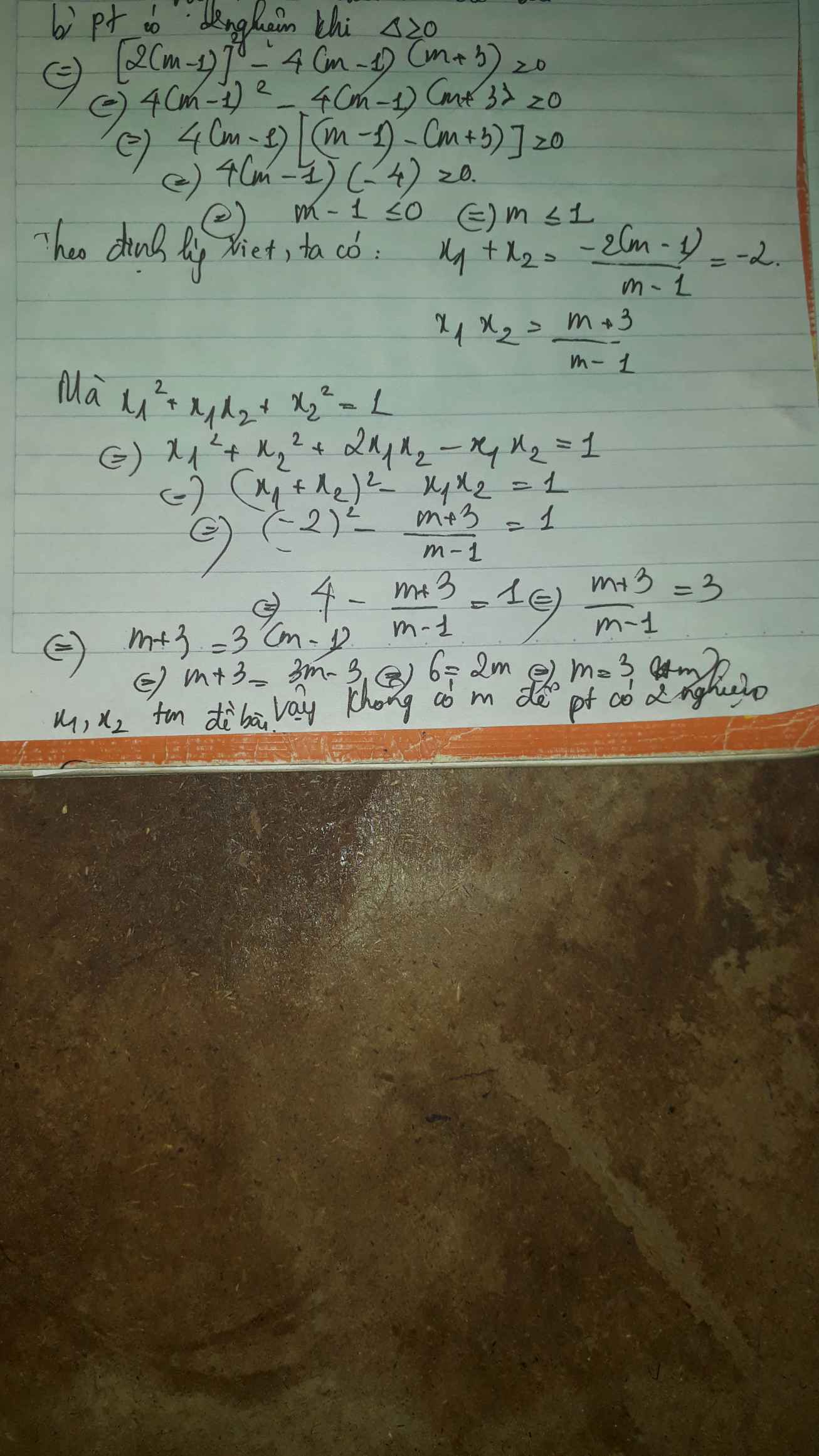Hãy nhập câu hỏi của bạn vào đây, nếu là tài khoản VIP, bạn sẽ được ưu tiên trả lời.

Lời giải:
Để pt có 2 nghiệm dương phân biệt thì:
\(\left\{\begin{matrix} \Delta=25-4(m-2)>0\\ S=5>0\\ P=m-2>0\end{matrix}\right.\Leftrightarrow 2< m< \frac{33}{4}\)
Khi đó:
\(2\left(\frac{1}{\sqrt{x_1}}+\frac{1}{\sqrt{x_2}}\right)=3\Leftrightarrow 4(\frac{1}{x_1}+\frac{1}{x_2}+\frac{2}{\sqrt{x_1x_2}})=9\)
\(\Leftrightarrow 4\left(\frac{5}{m-2}+\frac{2}{\sqrt{m-2}}\right)=9\)
\(\Leftrightarrow 4(5t^2+2t)=9\) với $t=\frac{1}{\sqrt{m-2}}$
$\Rightarrow t=\frac{1}{2}$
$\Leftrightarrow m=6$ (thỏa)

Ta có: \(\Delta=4m^2+4m-11\)
Để phương trình có 2 nghiệm phân biệt \(\Leftrightarrow4m^2+4m-11>0\)
Theo Vi-ét, ta có: \(\left\{{}\begin{matrix}x_1+x_2=2m+3\\x_1x_2=2m+5\end{matrix}\right.\)
Để phương trình có 2 nghiệm dương phân biệt
\(\Leftrightarrow\left\{{}\begin{matrix}4m^2+4m-11>0\\2m+3>0\\2m+5>0\end{matrix}\right.\) \(\Leftrightarrow\left\{{}\begin{matrix}\left[{}\begin{matrix}m< \dfrac{-1-2\sqrt{3}}{2}\\m>\dfrac{-1+2\sqrt{3}}{2}\end{matrix}\right.\\m>-\dfrac{3}{2}\\m>-\dfrac{5}{2}\end{matrix}\right.\) \(\Leftrightarrow m>\dfrac{-1+2\sqrt{3}}{2}\)
Mặt khác: \(\dfrac{1}{\sqrt{x_1}}+\dfrac{1}{\sqrt{x_2}}=\dfrac{4}{3}\)
\(\Rightarrow\dfrac{x_1+x_2+2\sqrt{x_1x_2}}{x_1x_2}=\dfrac{16}{9}\) \(\Rightarrow\dfrac{2m+3+2\sqrt{2m+5}}{2m+5}=\dfrac{16}{9}\)
\(\Rightarrow18m+27+18\sqrt{2m+5}=32m+80\)
\(\Leftrightarrow14m-53=18\sqrt{2m+5}\)
\(\Rightarrow\) ...

a. Với m=6 thì phương trình (1) có dạng
x^2 - 5x +4= 0
<=> (x-1)(x-4)=0
<=> x=1 hoặc x=4
Vậy m=6 thì phương trình có nghiệm x=1 hoặc x=4
b. Xét \(\text{ Δ}=\left(-5\right)^2-4\cdot1\cdot\left(m-2\right)=33-4m\)
Để (1) có nghiệm phân biệt khi \(m< \dfrac{33}{4}\)
Theo Vi-et ta có: \(x_1x_2=m-2;x_1+x_2=5\)
Để 2 nghiệm phương trình (1) dương khi m>2
Ta có:
\(\dfrac{1}{\sqrt{x_1}}+\dfrac{1}{\sqrt{x_2}}=\dfrac{3}{2}\Leftrightarrow\dfrac{1}{x_1}+\dfrac{1}{x_2}+\dfrac{2}{\sqrt{x_1x_2}}=\dfrac{9}{4}\\ \Leftrightarrow\dfrac{x_1+x_2}{x_1x_2}+\dfrac{2}{\sqrt{x_1x_2}}=\dfrac{9}{4}\\ \Leftrightarrow\dfrac{5}{m-2}+\dfrac{2}{\sqrt{m-2}}=\dfrac{9}{4}\Leftrightarrow20+8\sqrt{m-2}=9\left(m-2\right)\\ \Leftrightarrow\left(\sqrt{m-2}-2\right)\left(9\sqrt{m-2}+10\right)=0\Leftrightarrow\sqrt{m-2}=2\Leftrightarrow m-2=4\Leftrightarrow m=6\left(t.m\right)\)

`1)` Ptr có: `\Delta=3^2-4.5.(-1)=29 > 0 =>`Ptr có `2` nghiệm phân biệt
`=>` Áp dụng Viét có: `{(x_1+x_2=[-b]/a=-3/5),(x_1.x_2=c/a=-1/5):}`
Có: `A=(3x_1+2x_2)(3x_2+x_1)`
`A=9x_1x_2+3x_1 ^2+6x_2 ^2+2x_1x_2`
`A=8x_1x_2+3(x_1+x_2)^2=8.(-1/5)+3.(-3/5)^2=-13/25`
Vậy `A=-13/25`
____________________________________________________
`2)` Ptr có: `\Delta'=(-1)^2-7.(-3)=22 > 0=>` Ptr có `2` nghiệm pb
`=>` Áp dụng Viét có: `{(x_1+x_2=[-b]/a=2/7),(x_1.x_2=c/a=-3/7):}`
Có: `M=[7x_1 ^2-2x_1]/3+3/[7x_2 ^2-2x_2]`
`M=[(7x_1 ^2-2x_1)(7x_2 ^2-2x_2)+9]/[3(7x_2 ^2-2x_2)]`
`M=[49(x_1x_2)^2-14x_1 ^2 x_2-14x_1 x_2 ^2+4x_1x_2+9]/[3(7x_2 ^2-2x_2)]`
`M=[49.(-3/7)^2-14.(-3/7)(2/7)+4.(-3/7)+9]/[3x_2(7x_2-2)]`
`M=6/[x_2(7x_2-2)]` `(1)`
Có: `x_1+x_2=2/7=>x_1=2/7-x_2`
Thay vào `x_1.x_2=-3/7 =>(2/7-x_2)x_2=-3/7`
`<=>-x_2 ^2+2/7 x_2+3/7=0<=>x_2=[1+-\sqrt{22}]/7`
`@x_2=[1+\sqrt{22}]/7=>M=6/[[1+\sqrt{22}]/7(7 .[1+\sqrt{22}]/2-2)]=2`
`@x_2=[1-\sqrt{22}]/7=>M=6/[[1-\sqrt{22}]/7(7 .[1-\sqrt{22}]/2-2)]=2`
Vậy `M=2`

\(x^2-\left(m+1\right)x+m+4=0\left(1\right)\)
\(\Rightarrow\Delta>0\Leftrightarrow\left(m+1\right)^2-4\left(m+4\right)>0\Leftrightarrow\left[{}\begin{matrix}m< -3\\m>5\end{matrix}\right.\)\(\left(2\right)\)
\(ddkt-thỏa:\sqrt{x1}+\sqrt{x2}=2\sqrt{3}\)
\(x1=0\Rightarrow\left(1\right)\Leftrightarrow m=-4\Rightarrow\left(1\right)\Leftrightarrow x^2+3x=0\Leftrightarrow\left[{}\begin{matrix}x1=0\\x2=-3< 0\left(loại\right)\end{matrix}\right.\)
\(x1\ne0\) \(\Rightarrow0< x1< x2\)
\(\Leftrightarrow\left\{{}\begin{matrix}x1+x2>0\\x1x2>0\end{matrix}\right.\Leftrightarrow\left\{{}\begin{matrix}m+1>0\\m+4>0\end{matrix}\right.\)\(\Rightarrow m>-1\)\(\left(3\right)\)
\(\left(2\right)\left(3\right)\Rightarrow m>5\)
\(\Rightarrow\sqrt{x1}+\sqrt{x2}=2\sqrt{3}\)
\(\Leftrightarrow x1+x2+2\sqrt{x1x2}=12\Leftrightarrow m+1+2\sqrt{m+4}=12\)
\(\Leftrightarrow m+4+2\sqrt{m+4}-15=0\)
\(đặt:\sqrt{m+4}=t>5\Rightarrow t^2+2t-15=0\Leftrightarrow\left[{}\begin{matrix}t=-5\left(ktm\right)\\t=3\left(ktm\right)\end{matrix}\right.\)
\(\Rightarrow m\in\phi\)
Để pt có 2 nghiệm pb
\(\left(m+1\right)^2-4\left(m+4\right)=m^2+2m+1-4m-16\)
\(=m^2-2m-15>0\)
Theo Vi et \(\left\{{}\begin{matrix}x_1+x_2=m+1\\x_1x_2=m+4\end{matrix}\right.\)
Ta có : \(\left(\sqrt{x_1}+\sqrt{x_2}\right)^2=12\Leftrightarrow x_1+2\sqrt{x_1x_2}+x_2=12\)
Thay vào ta được \(m+1+2\sqrt{m+4}=12\Leftrightarrow2\sqrt{m+4}=11-m\)đk : m >= -4
\(\Leftrightarrow4\left(m+4\right)=121-22m+m^2\Leftrightarrow m^2-26m+105=0\)
\(\Leftrightarrow m=21\left(ktm\right);m=5\left(ktm\right)\)

Δ=(m+2)^2-4*2m=(m-2)^2
Để PT có hai nghiệm pb thì m-2<>0
=>m<>2
\(\dfrac{1}{x_1}+\dfrac{1}{x_2}=\dfrac{x_1x_2}{4}\)
=>\(\dfrac{x_1+x_2}{x_1x_2}=\dfrac{x_1x_2}{4}\)
=>\(\dfrac{m+2}{2m}=\dfrac{2m}{4}=\dfrac{m}{2}\)
=>2m^2=2m+4
=>m^2-m-2=0
=>m=2(loại) hoặc m=-1

\(\Delta=9-4m>0\Rightarrow m< \dfrac{9}{4}\)
Theo hệ thức Viet: \(\left\{{}\begin{matrix}x_1+x_2=3\\x_1x_2=m\end{matrix}\right.\)
\(\sqrt{x_1^2+1}+\sqrt{x_2^2+1}=3\sqrt{3}\)
\(\Leftrightarrow x_1^2+x_2^2+2+2\sqrt{\left(x_1^2+1\right)\left(x_2^2+1\right)}=27\)
\(\Leftrightarrow\left(x_1+x_2\right)^2-2x_1x_2+2\sqrt{\left(x_1x_2\right)^2+\left(x_1+x_2\right)^2-2x_1x_2+1}=25\)
\(\Leftrightarrow9-2m+2\sqrt{m^2+9-2m+1}=25\)
\(\Leftrightarrow\sqrt{m^2-2m+10}=m+8\left(m\ge-8\right)\)
\(\Leftrightarrow m^2-2m+10=m^2+16m+64\)
\(\Rightarrow m=-3\) (thỏa mãn)
Pt trên có a=1, b=5, c=-3m+2
\(\Delta=b^2-4ac=25-4\cdot1\cdot\left(-3m+2\right)=17+12m\)
Để pt có hai nghiệm phân biệt thì \(\Delta>0\)<=> 17+12m >0 <=>m> 17/12
Theo hệ thức Viet, ta có:
\(\hept{\begin{cases}x_1+x_2=-5\\x_1\cdot x_2=-3m+2\end{cases}}\)
\(\left(x_1-x_2\right)^2=\left(x_1+x_2\right)^2-4x_1\cdot x_2=25-4\left(-3m+2\right)=17+12m=10\)
=> 12m = -7 <=>m=-7/12 (thỏa đkxđ)
Vậy với m=-7/12 thì phương trình có hai nghiệm x1, x2 thỏa (x1 - x2)^2 =10

b) phương trình có 2 nghiệm \(\Leftrightarrow\Delta'\ge0\)
\(\Leftrightarrow\left(m-1\right)^2-\left(m-1\right)\left(m+3\right)\ge0\)
\(\Leftrightarrow m^2-2m+1-m^2-3m+m+3\ge0\)
\(\Leftrightarrow-4m+4\ge0\)
\(\Leftrightarrow m\le1\)
Ta có: \(x_1^2+x_1x_2+x_2^2=1\)
\(\Leftrightarrow\left(x_1+x_2\right)^2-2x_1x_2=1\)
Theo viet: \(\left\{{}\begin{matrix}x_1+x_2=-\dfrac{b}{a}=2\left(m-1\right)\\x_1x_2=\dfrac{c}{a}=m+3\end{matrix}\right.\)
\(\Leftrightarrow\left[-2\left(m-1\right)^2\right]-2\left(m+3\right)=1\)
\(\Leftrightarrow4m^2-8m+4-2m-6-1=0\)
\(\Leftrightarrow4m^2-10m-3=0\)
\(\Leftrightarrow\left[{}\begin{matrix}m_1=\dfrac{5+\sqrt{37}}{4}\left(ktm\right)\\m_2=\dfrac{5-\sqrt{37}}{4}\left(tm\right)\end{matrix}\right.\Rightarrow m=\dfrac{5-\sqrt{37}}{4}\)

CHÚC BẠN HỌC TỐT NHÁ